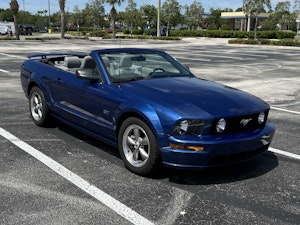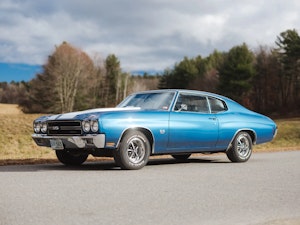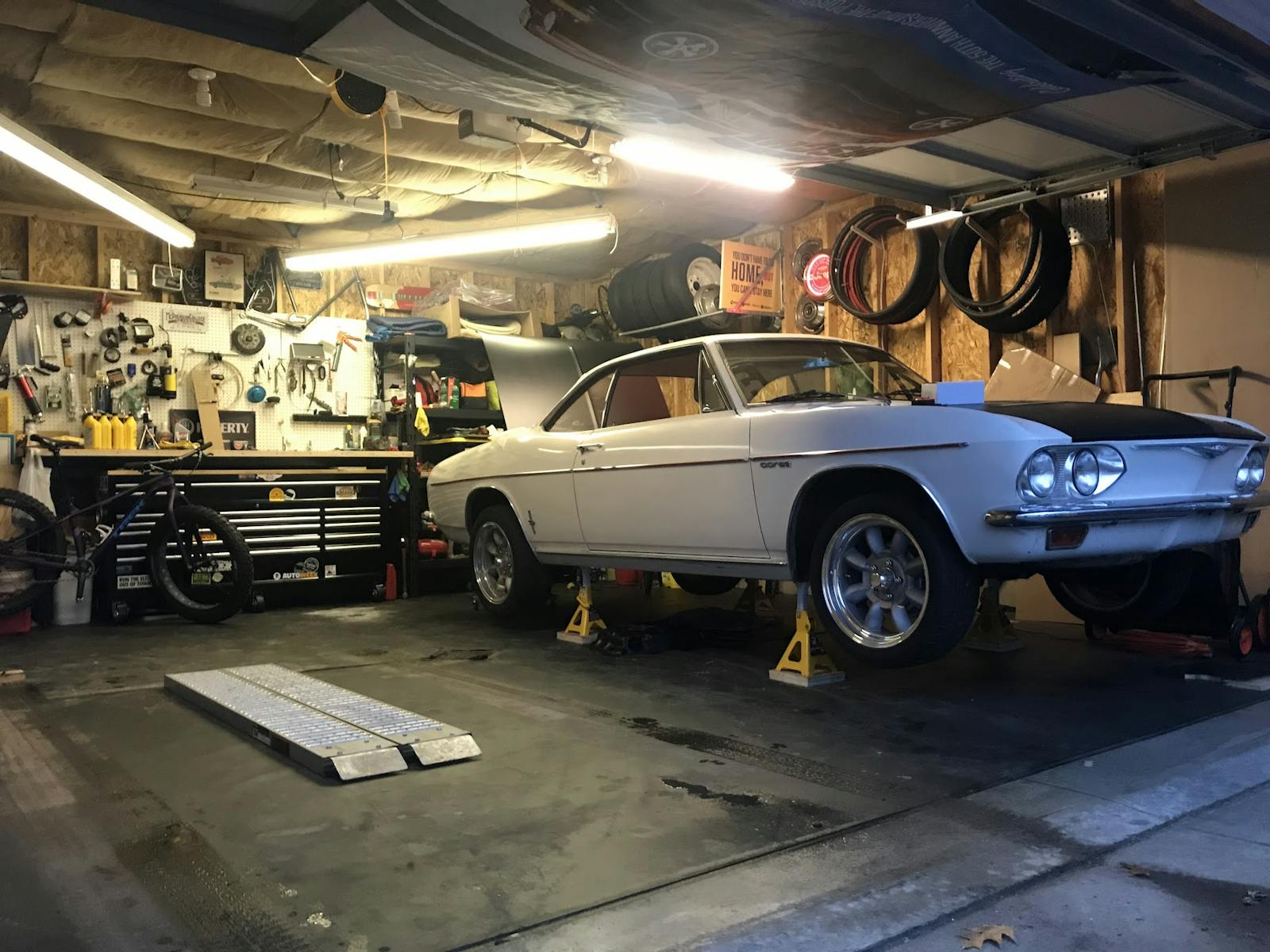Media | Articles
4 Things You Learn Refreshing a Flathead Ford V-8
One of the more interesting parts of working on cars is working on various cars. Every iteration of the automobile wears fingerprints of the time it was built, the people who built it, and the resources at hand. If one pays attention as the ratchet swings, those fingerprints can offer some interesting context and insight into a time that we may not have even experienced firsthand. In other words, working on old cars can be a means of time travel. I recently traveled back to the 1950s by getting elbow-deep in a Ford 8BA flathead V-8. I picked up a few fun reminders and learned a bit along the way.
The flathead I got my hands on was unceremoniously yanked from a 1946 Ford pickup. The truck is the same one that a crew of Hagerty employees, in 2015, assembled from parts found at the Antique Automobile Club of America Hershey fall swap meet. Back then it was a tired old V-8, but in 2018 Davin gave the engine the Redline Rebuild treatment. Since then the truck has been racking up miles as a parts runner and more. After nearly seven years of driving with not much more than just oil changes, Davin and I agreed it was time to fix a few of the annoying small leaks, plus perform a curiosity check of how the internals are doing. It was a job I actually undertook in the Hagerty booth during the Detroit Auto Show last week, and here are four things I can’t stop thinking about since.
Just How Simple These Old Beasts Are



An engine is a mechanical means of turning fuel into work. It is possible to create simpler engines than the Ford flathead, but there is something special about this V-8 and how it functions. (We even dedicated a whole feature story to describing how it gave power to the masses.) Durability was clearly top of mind when creating the flathead, and it shows in the limited number of parts and basic design. While it would be possible to flow enough water through the engine with a single water pump, the easier and more durable design was to place two pumps directly into the front of the block. (Fewer gaskets, seals, and hardware.) Heck, the whole thing is only held together with a few dozen bolts.
They’re Overbuilt and Understressed



Ford used lot of cast iron to create each flathead V-8. From someone who has turned wrenches on cars that range in age from 120 years old to under 10—though mainly for fun and frugality reasons—I find it shocking to witness the robustness of the 8BA. The extra material around each threaded hole, and how deep the threads are on parts that don’t need massive clamping loads, are just a couple of examples that demonstrate this design’s focus on function first and production cost second. Yes, the contemporary manufacturing process factored in, but it is obvious that the technology of finite element analysis was still decades away from chiseling things down to only what was needed, with just enough to spare. Ford in these days would rather be safe than sorry.
A Handful of Tools Is Plenty

My whole refresh of this engine, performed live on the show floor of the 2025 Detroit Auto Show, only took a few days due to the relatively limited scope of the work. (Tear down, re-gasket, reassemble.) Still, it was a little silly to only need a handful of sockets and one or two wrenches to strip the whole thing and turn it into a rotating assembly. Jokes abound about being able to rebuild an American car with only a 1/2″, 9/16″, and a big hammer abound… but it is at least kind of true here.
Marketplace
Buy and sell classics with confidence
One of my most ingrained habits when working on cars is not putting tools in my pockets, because that’s how I tend to lose things. While working on this engine, it was all but impossible to keep myself from just dropping a ratchet or wrench in my back pocket because I knew it would likely be the next tool I’d need. Nearly all the tools I needed indeed fit in my pockets—and all at once, to boot!
More than anything, this V-8 came apart easily and quickly. Working in the quiet that comes from eschewing pneumatic and electric tools is as shocking to the brain as it is fun.
It’s Easy to Become an Automotive Hypochondriac

Maybe you caught it in this story’s introduction, but this teardown was mainly for cosmetic reasons. There were no noises, damage, vibrations, or other concerning signs that this V-8 needed anything more than another good long drive to keep it happy. It might be an old engine, but more than anything it is a mechanical system designed to do work, and so long as it is still functional, it is usually best in the case of old things to let sleeping dogs lie.
These days, with modern technology and manufacturing, we often don’t have to wipe up a drop or two when the truck gets moved around the shop. But is that really such a bad thing? Do I care if this engine looks a little crummy, if it’s working fine? Did I spend a few days “fixing” something that was not broken at all? Oh well, it was still fun, and plenty of people at the Auto Show hoping to get a glimpse of new metal instead got to ogle at an old flathead in pieces. I sure get a kick out of that.






















Strong. Simple and Smooth.
Great little engines. The only thing they need is better air flow and less weight. And that is just what the racers did with them back in the day.
I’m a Chevy guy but if I built a 32 Coupe it would be a Ford flat head with aftermarket heads and intake up front. A little more compression too.
I’d like to do the same.
Now I’m wondering… Did they also make aluminum water pumps?
Did they? No. But someone does now, and Speedway sells them.
I have a 1942 1 ton Jailbar. Its 1949-53 8RT is currently sitting in the shop waiting for me to get back to it.
One question I have is regarding the head gaskets.
The new ones have a much smaller hole for water passage between the middle pistons than the holes in the block. Should I cut those holes in the gasket larger to match the holes in the block? Maybe the gaskets are for 8BA and the 8RT needs more flow.
Back in the 60s in Cleveland when I was in high school, I hung around a gas station where the owner raced a ’50 Ford Coupe with a flathead on short oval tracks. Learned a lot about cars and engines. You never wanted a flathead to overheat, because there was danger of the block cracking between the valve seats and the cylinder bore. The material thickness was reduced in that area by machining to get better airflow into the cylinder but it was a compromise of strength (called “relieving the block”). That was really the only weak point I can remember.
I can remember reading in Hot Rod magazine back in the 60’s when guys were still running flathead that their descriptioin often mentioined ported, polished and relieved. I never knew what relieved was. Thanks for letting me know after all these years.
One grinds away material on the inside of bends in the air and exhaust passages. This straightens out the bend a bit and enlarges that portion of the passage.
You are describing “porting”. “Relieving” is removing material on the top of the block between the valves and the cylinder. It will provide a larger opening for the air/fuel mixture to flow through. Unfortunately, it causes a reduction in compression. Relieving is usually beneficial on highly modified engines. It doesn’t help on stock or near stock engines. It has been said that the factory reliefs were added to reduce block cracking, not increase performance. Since it is seen mainly on truck engines, it makes sense..
From “Little Deuce Coupe” by Jan and Dean:
“Shes’ ported and relieved and shes’ stroked and bored”
By Brian Wilson /Roger Christian. Recorded by The Beach Boys
I used a 46 truck block. It was factory relieved.
I had a 1941 Ford flathead with dual 2BBLs in a “crackerjack” speedboat in 1966. It had no transmission- you’d point the boat to clear water, fire it up and go! Later, I had a 1953 Ford flathead marine conversion in a 1920s 33′ USN captain’s gig hull, converted to a pleasure cruiser. Ran quiet and smooth. In the mid-later 1960s, we used to buy old 1946-1948 Ford cars for $50-$150 and bomb around in them. All flatheads. Easy to work on. And parts were dirt cheap back then.
I had a ’53 Ford flathead with Mercury replacement motor. Could stand for my teenage driving, but failed the overheating challenge. Cracked most of the valve seats. But for that, the engine would have easily outlasted the ranch Wagon body.
It’s pretty clear that “back in the day”, providing just the minimum amount of material, and parsing same down to the last hundredth of a penny, wasn’t on the engineers’ minds…unlike, say, the engine & trans mounts on my 2019 Ford Escape. Also, according to a couple biographies of Henry Ford and the early days of Ford Motor Co, Henry intended the servicing & repairs to require few tools. No doubt a commonality of fasteners also cut production costs as well.
Henry Ford was a repairman and mechanic before he started building cars, so repairing and accessability was built into his approach. Unlike the idiots designing cars today.
I’ve read that the real story behind the flathead was the innovation in casting that was needed to make it. That may also explain the “extra” material around bolt holes etc.
Yep – it was the first V-8 in which the block could be cast in one piece. I agree with you about the reason for the “extra” material.
When I was in High School Shop Class, I brought my Grandpas 1947 Ford 1ton grain truck and we overhauled it. Easy engine to work on with the help of a older Mechanic that had all of the special tools needed to pull out the valves so we could get the seats and guides redone. Had 4 lifters that were bad and finding parts was not very difficult. Learned alot and the Old girl is still running today only for Parades but she still purrs like a kitten.
My
If you ever worked on an old Briggs and Stratton air cooled engine they are pretty much like a flathead Ford without the water jacket in the block and heads. Simple and reliable is the key words. The cooling problems stemmed from the fact the exhaust gas goes back thru the engine block before they exit, something you don’t have on an OHV engine. The aftermarket OHV conversions like from Ardun solved that problem and also greatly increased the HP as well. Fun fact, they were initially marketed to commercial users like trucking firms.
Kyle, you remark that you could probably deal with all those parts even if they had no labels. That was probably deliberate on old Henry’s part. Most of his employees in 1932 would not have been able to read.
Great article. Almost made me want to find a flathead and rebuild it just for fun. But then that would lead into another whole adventure finding and building a suitable car to put it in!!! Too old for that now.
Before you go any further with that, watch Davin’s “Redline Rebuild” video of this engine. Rebuilding one of these is about twice as much work as doing something like a small-block Chevy. That’s also reflected in the prices most shops will charge.
i have that flathead in my 47 pickup. its a 50 model and it been with me since 1980. I rebuilt it 5 years ago, added a edelbrock 4 barrel manifold and holley 390. always runs great. ill have it till they bury me.
Here’s an article about a ’32 with an all aluminum flathead…
https://www.hotrod.com/features/1933-ford-cabriolet-aluminum-flathead-engine-shadow-rods/
I have a ’46 Ford flathead in a ’36 Ford pickup. It’s the first flathead I’ve ever worked on and every task is an adventure. They are indeed robust and simple, and aluminum heads go a long way toward reducing heat. In fact, I recently had to add 180-degree thermostats to each head spout just to get it up to a reasonable operating temperature in the winter. Just to do this simple task, I had to drill and tap holes in each spout rim to secure the thermostats…..but now it gets to around 175 quickly and runs cleanly. Acceleration is surprisingly good, especially after installing an Offenhauser Super-Dual Stromber 97 intake, and shifting is a breeze with a new Tremec T5. Initially, I was going to pull the flathead to install the ubiquitous crate 350. Thank heavens I didn’t.
Me too. I’ve got a ’40 Ford coupe that I’d like to put a Tremec 5 speed in. Do they make adapters to mate the trans to the flat head bell housing? What did you use?
Speedway Motors is a good source as is Summit Racing. Have a T-5 tranny in my 40 with a 59A flatty and am well pleased.
this story reminds me of a time way back in the early 60’s. I was 9yo and up to my elbows in oil in my dad’s workshop. He was Managing Director of an engine reconditioning shop in North Queensland Australia. My younger brother and I would go to ‘work’ with dad every school holiday and ‘help’ the machinists tear down, re-finish and assemble all makes and model of the current engines. I will never forget when Clif, the lead machinist in the re-assembly shop asked me to give him a hand with a flathead Ford V8. My job was to fit together the valve guides and valve, then place into the block. Clif would then follow up with the valve spring etc. This was so much fun seeing how all these components went together.
I was taught how to re-meta conrods and mains, assemble the crankshaft and conrods, install piston rings etc. In the actual machine shop section I was taught how to align bore a block, surface grind heads, cut valve seats and re-face valves. By the time I was 12, I was grinding crankshafts, I was a fairly good welder and was taught how to braze.
Ah these were the days. I returned to Dad’s ‘shop many times over the years after leaving school. On one such trip home, I asked Dad if I could carry out a re-ring on my 1275cc Cooper S. He said sure, the shop is closed for Christmas holidays, but, you have to clean all the machines and repaint them first. Ok, sure. It took 2 weeks to get that job done, and then another 2 weeks to do my Mini engine, a BMC A series. Da surprised me when he presented me with the ‘build sheet’ from BMC complete with all the ‘go-no go’ sizes. Well we were doing a Blue Print engine in a pristine engine reconditioning shop. That was the most fun ever.
At the end, that little 1275 would free rev to 8500RPM with a full glass of water on the tappet cover and not spill a drop.
Today, we just remove an engine and toss it on the junk heap. Henry had the right idea
I enjoyed the article .I never worked on one ,but always admired the ingenuity that was used in originals and racers who tuned them for more power.